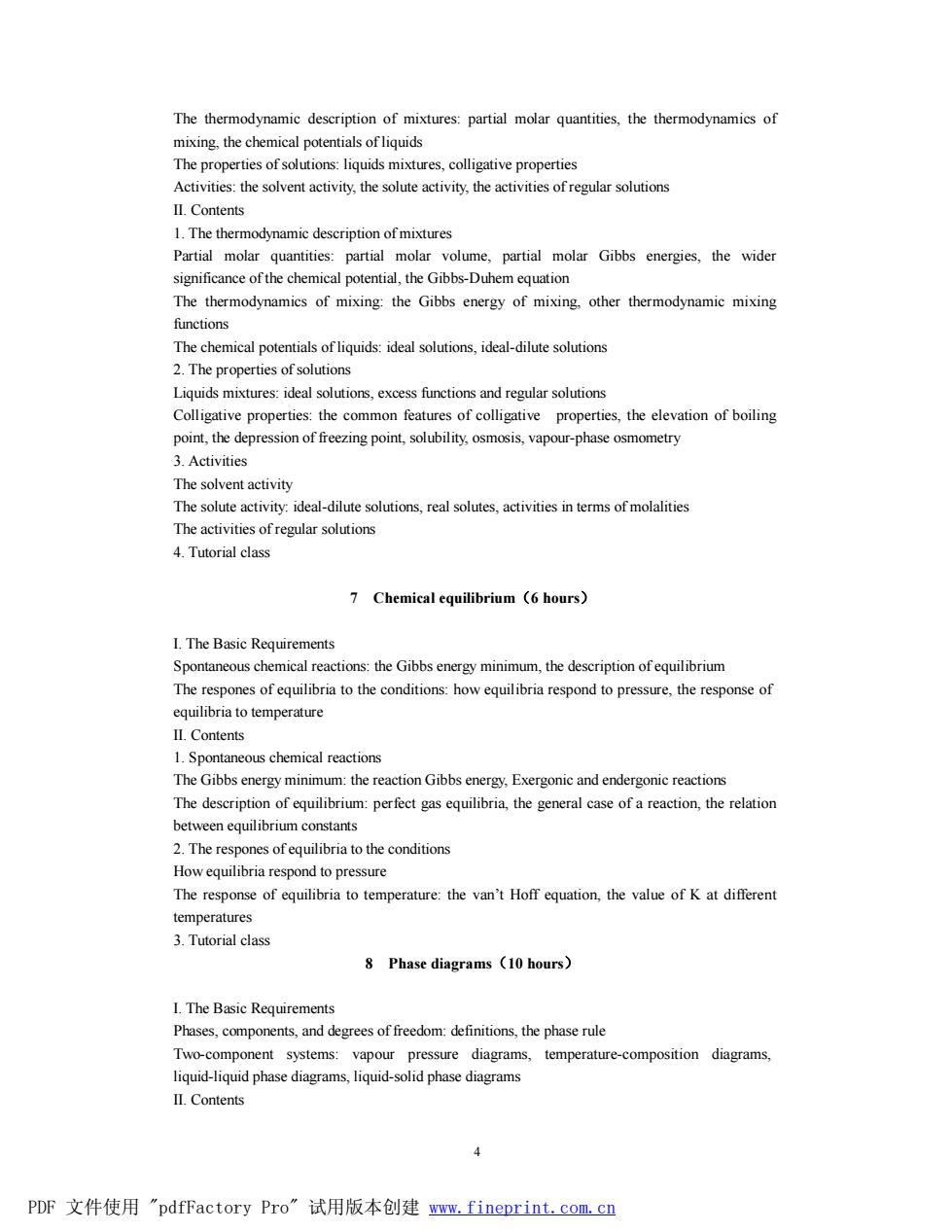正在加载图片...

The thermodynamic description of mixtures:partial molar quantities,the thermodynamics of Activities:the solvent activity,the solute activity,the activities of regular solutions II.Contents 1.The thermodynamic description of mixtures partial molar volume,partial molar bb the wider nical entia the Gibbs-Duhemo The thermodynamics of mixing:the Gibbs energy of mixing.other thermodynamic mixing functions The chemical potentials of liquids:ideal solutions,ideal-dilute solutions 2.The properties of solutions Liquidsmitresidcealsolutios,cxcesfrnctosamdregularsoltions properties:thecommo features of,of boiing point,the depression of freezing point,solubility,osmosis,vapour-phase osmometry 3.Activities The solvent activity The solute activity:ideal-dilute solutions,real solutes,activities in terms of molalities 4.Tutorial class 7 Chemical equilibrium (6 hours) 1.The Basic Requirements Spontaneous chemical the Gbbs energy minimum,the description The respones ofequlibria to the conditions:how equilibria respond to pressure,the response of equilibria to temperature II.Contents 1.Spontaneous chemical The Gibbs nergy minimum:the enery Exergonic and endergon The description of equilibrium:perfect gas equilibria,the general case of a reaction,the relation between equilibrium constants 2.The respones ofequilibria to the conditions How equilibria respond to pressure The response of quilibria to temperature:the van't Hoff quation,the value of K at differen 3.Tutorial class 8 Phase diagrams (10 hours) I The basic requirements Phases.degrees of freedm:finitions,the phase rule Two-component systems:vapour pressure diagrams.temperature-composition diagrams. liquid-liquid phase diagrams,liquid-solid phase diagrams II.Contents PDF文件使用"pdfFactory Pro”试用版本创建n,fineprint,com,cn 4 The thermodynamic description of mixtures: partial molar quantities, the thermodynamics of mixing, the chemical potentials of liquids The properties of solutions: liquids mixtures, colligative properties Activities: the solvent activity, the solute activity, the activities of regular solutions II. Contents 1. The thermodynamic description of mixtures Partial molar quantities: partial molar volume, partial molar Gibbs energies, the wider significance of the chemical potential, the Gibbs-Duhem equation The thermodynamics of mixing: the Gibbs energy of mixing, other thermodynamic mixing functions The chemical potentials of liquids: ideal solutions, ideal-dilute solutions 2. The properties of solutions Liquids mixtures: ideal solutions, excess functions and regular solutions Colligative properties: the common features of colligative properties, the elevation of boiling point, the depression of freezing point, solubility, osmosis, vapour-phase osmometry 3. Activities The solvent activity The solute activity: ideal-dilute solutions, real solutes, activities in terms of molalities The activities of regular solutions 4. Tutorial class 7 Chemical equilibrium(6 hours) I. The Basic Requirements Spontaneous chemical reactions: the Gibbs energy minimum, the description of equilibrium The respones of equilibria to the conditions: how equilibria respond to pressure, the response of equilibria to temperature II. Contents 1. Spontaneous chemical reactions The Gibbs energy minimum: the reaction Gibbs energy, Exergonic and endergonic reactions The description of equilibrium: perfect gas equilibria, the general case of a reaction, the relation between equilibrium constants 2. The respones of equilibria to the conditions How equilibria respond to pressure The response of equilibria to temperature: the van’t Hoff equation, the value of K at different temperatures 3. Tutorial class 8 Phase diagrams(10 hours) I. The Basic Requirements Phases, components, and degrees of freedom: definitions, the phase rule Two-component systems: vapour pressure diagrams, temperature-composition diagrams, liquid-liquid phase diagrams, liquid-solid phase diagrams II. Contents PDF 文件使用 "pdfFactory Pro" 试用版本创建 www.fineprint.com.cn